1.Introduction
Note-taking is one of the most critical processes in no matter consecutive interpretation or simultaneous interpretation [1]. Especially for consecutive interpretation, according to Chang, interpreting notes not only served as a memory storage tool, but also a visual language containing logic and meanings(2014,7). During the process of interpreting, memory, saving, and the extraction of the source language are detrimental factors for interpreting performance, while memory is the most important one among all three elements. Therefore, the cooperation between note-taking and memorization becomes the key. Ideally, interpreters can use note-taking as a tool to support their memory so that they can decode the input into output. However, the processes of listening and writing are a trade-off due to the limited capacity of the brain [2]. To be more specific, when you are taking notes, your brain will be distracted from processing new information from the source language. At the same time, note-taking skills cannot be learned in a short period, yet interpreters have to spend considerable time and practice constructing their note-taking system. Therefore, effectively using notes to help interpreters save and memorize information from source language becomes crucial. I want to work on the linguistic study of interpreters’ note-taking systems to improve interpretation efficiency. I am going to explore how linguistics and symbols are deployed in the process of note-taking. In this study, a quantitative research will be used to examine the causality between note-taking efficiency and interpreters’ performance.
2.Literature Review
Gile proposed the Effort Model in 1992, which helps interpreters understand the difficulty of interpreting. Gile divided the interpreting process into two phases: phase one, listening and analysis plus Note-taking plus Short-term memory operations plus coordination, and phase two, remembering plus note-reading plus production. During phase one, slow hand movement puts burden on interpreter’s short-term memory, resulting in rendition of poor interpreting quality. The four efforts: listening and analysis, memory, production, and coordination guided interpreters to find balance, at the same time, provided appropriate strategy. However, according to Dam, most early research on note-taking in consecutive interpreting focused on note-taking structure and note-taking method [3]. For example, Merlini stated that “interpreting processes can be divided into the perception of sounds, analysis, and note taking.” [4]. As these three steps work simultaneously during interpretation, interpreters should first process information – finding internal connections, developing logical sequences, and classifying similarities - while taking notes [4]. Through such information processing, interpreters can form semantic memory - a long-term memory that helps strengthen understanding of the source language. Recently, research on interpreting note-taking can be divided into the following categories:
(1) Form of the notes should be considered as a factor influencing interpreting quality [5]. The form included the language usage, symbols, and words count. They concluded that writing more notes is more effective than writing less; applying more abbreviations helps improve the speed of information processing; Using source language is more accessible for interpreters to understand compared with the target language based on the different levels of mastery of language.
As Helle V. Dam is a Danish interpreter, her research mainly focused on Danish – Spanish interpreting. However, Danish is a Germanic language, while Spanish is a Romance language (European and their languages). These two language families cannot be explained under the context of English – Chinese translation. Therefore, it is necessary to explore more empirical examples of Chinese and English translation.
(2)Wang & Zhou aimed at finding the correlation between the content note and interpreting output. The result showed that note helps interpreters memorize important information and produce correct output. However, some mistakes lead by taking notes still reduce interpreting quality [6].
(3) According to Merlini the content of notes is not rigid. Logical links should be analyzed, yet subjects, verbs, and objects are not necessary. He suggested two recommended note-taking principles, including “vertical listing of analogous elements of a clause” and “diagonal arrangement of notes”
(4)For the note’s language, different experts hold different opinions. For example, W holds that target language should be the main language, which helps the interpreter save processing time. However, Some people disagree, insisting that as the importing part costs a big part of cognitive capacity, including following up speaker’s speaking speed, searching and filtering information, and catching main point, interpreters should not spend extra energy to achieve code switching, avoiding additional burden Current research on interpretation notes does not have a comprehensive but targeted paper focused on Chinese-English interpreting note traits which this paper is going to explore.
3.Research Method
3.1.Participant: Year 3 Students in CUHK(SZ)
Sample 1 & 2: Students majored in translation who have received professional interpreting training for one year.
Sample 3 & 4: students who do not major in translation
3.2.Interpreting Task
A material from the China-UK forum that was extracted from Field Interpreting written by Lin Chaolun. It’s a traditional political speech with formal language, parallel structures, and professional vocabulary. The listening material has 592 characters, and the audio lasts around five minutes.
3.3.Experiment Process
1. the researcher will test four samples individually via zoom or Tencent app.
2. Researcher plays the video to subjects online via Zoom. The process of the experiment will be recorded for analysis.
3. The listing material was cut into six chunks. While listening to the materials, students should take notes and make consecutive interpretations.
3.4.Interpreting notes
As the focus of the research is exploring note traits, the researcher should collect notes after interpreting ends. Notes from the experiment samples will be displayed in the appendix.
3.5.Data Analysis
Data analysis will be conducted in Excel. Interpreting note traits will be divided into seven parts based on the early research: Characters, Complete words, abbreviations, symbol&number, English characters, Chinese characters, and logic connection words.
4.Results
Table 1: Comparison between word count.
Sample |
Characters |
Average |
S1 |
66 |
|
S2 |
57 |
62 |
S3 |
101 |
|
S4 |
131 |
116 |
(2)From table 1, it can be discovered that the difference in word count is significant. The word count for untrained group and trained group are separately 66, 57, 101, 131. The average word count of the untrained group is 54 words more than the trained group.
Table 2: Comparison between note form.
Sample |
Complete Words |
Abbreviation |
Symbols&number |
Logic connection words |
S1 |
49 |
7 |
16 |
0 |
S2 |
30 |
10 |
5 |
0 |
S1+S2 |
79 |
17 |
21 |
0 |
S3 |
9 |
15 |
32 |
15 |
S4 |
20 |
18 |
40 |
10 |
S3+S4 |
29 |
33 |
72 |
25 |
(2)For the untrained group, abbreviation only contains common words like “globalization”, “WTO”, or long words like “environment”, and “ecology”. In Contrast, the trained group use abbreviation in a broader range and have own abbreviation system, especially for nouns. Both students in the trained group use symbols or abbreviations to replace long words. Moreover, trained group uses numerous brackets, arrows, and stars to substitute long words and express logics that the untrained group write down in their notes.
(3)Based on the note script, the researcher compared the form of the notes by analyzing the following four dimensions: Word Length (Complete words), abbreviation, symbols and numbers, and logic connection words. From table 2, the untrained group writes 79 complete words, while the trained group writes 29 completes with shorter word lengths. What is more, the trained group wrote more abbreviations (17,33), symbols and numbers (21,72), and logic connections (0,25).
Table 3: Comparison between language use.
Sample |
English |
Chinese |
S1 |
61 |
1 |
S2 |
52 |
0 |
S3 |
34 |
31 |
S4 |
61 |
28 |
(1) Table 3 focuses on comparing the difference in language use. For sample 1 and 2, they hardly use Chinese as their note language. However, sample 3 and 4 uses Chinese frequently.
(2) Based on the performances of the four samples, the trained group is more efficient than the untrained group. The former one missed less information and had more fidelity to the original text. Therefore, it can be deduced that word number, note form, and language all are factors that influence interpreting efficiency. The following part will explore the underlying reasons.
5.Discussion
5.1.Word Number and Interpreting Efficiency
The statistics lead to a hypothesis that the more the word number, the higher the efficiency. However, there is no causality between word number of notes and interpreting efficiency because different people have different memory capacity and cognitive capacity [7]. Therefore, individuals cannot conclude cause-effect relation between the word number of the notes and interpreting efficiency by only using the word count as a parameter. However, by analyzing the structure of each note by different experiment samples, the researcher finds that the trained group has better-structured notes with comprehensive information. As Zhou &Dong has proved the familiarity of note-taking and interpreting efficiency, the untrained group is less familiar with the coordination of writing and listening. Comparing the layout of notes in different groups, the researcher finds that the trained group is well structured with a unified structure. They also vertically take notes with broader space. As they are more familiar with the note-taking system, they handle the listening part less demanding but export efficiently. Thus, the word count of notes positively correlates with interpreting efficiency.
5.2.Note Traits and Interpreting Efficiency
For note traits, the untrained group writes longer words or complete words. However, the trained group make wiser decisions when they construct their notes. As Merlini divided the listening part into five steps, the untrained group may only copy what they hear from the material without selecting keywords or analyzing logic [8].
What is more, table 2 also shows that there is a significant difference between the trained group and the untrained group in abbreviations, symbols and numbers, and logic words. In notes of the untrained group, there is little abbreviation, symbol, number, and logic words. Wang & Zhou proves this conclusion by insisting that using symbols and abbreviation saves time for interpreters to keep up with listening material. What is more, it is concise and efficient for interpreters to use parentheses to record parallel examples, arrows to express cause and effect, and different symbols to display different logics.
5.3.Language Use in Notes
In this experiment, the result shows that the untrained group hardly use Chinese when taking notes. Dam explored the mechanism under such phenomenon, insisting that source language is less demanding for interpreters to directly write down what they hear without dealing with language conversion. However, such way of note-taking is more like dictating instead of processing information in the brain. Therefore, the untrained group lacks the process of information decoding. Listening to the output of the untrained group, the researcher found that the untrained group only takes notes for writing but does not play a role in memory assistance.
This research aims at producing a descriptive study rather than a conclusive argument. Therefore, there is no definite conclusion throughout the whole research. At the same time, the study still needs improvements. The sample size is too small to obtain a valid statistic. At the same time, the trained group is from interpreting sophomore students instead of a professional interpreter; thus, the results may not be very accurate.
Referencces
[1]Nolan J.2005.Interpreting:Techniques and Exercises.Clevedon:Multilingual Matters.
[2]Liu & M.D.Schallert&P.Carrol.“Working memory and expertise in simultaneous interpreting” Interpreting6(1):19-42. (2004).
[3]Dam, Helle V. “The Interpreters’ Notes.” Claims, Changes and Challenges in Translation Studies, 2004, 251–61. https://doi.org/10.1075/btl.50.21dam.
[4]Merlini Raffaella. “Interpit- consecutive interpretation module”. The Interpreter Newsletter 7:31-41.
[5]Dam H. 2004a.Interpreters’ notes:On the choice of form and language. Claims, Changes and Challenges in Translation Studies: 6(1): 3-17.
[6]Yuwen Wang, Dandan Zhou. An empirical study on the relationship between the content of interpreting notes and interpreting output. Journal of PLA University of Foreign Languages:115-121.2014.
[7]Weihe Zhong. Discussion on Interpreting Teaching. Practical Interpreting Handbook:1998:18-21.
[8]Burgin, Mark, and John H Schumann. “Three Levels of the Symbolosphere.” Semiotica 2006, no. 160 (2006). https://doi.org/10.1515/sem.2006.045.
Sample 1:
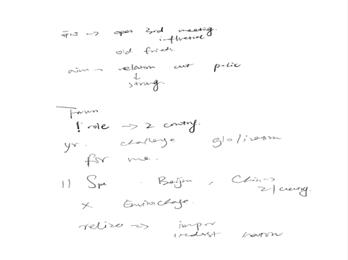
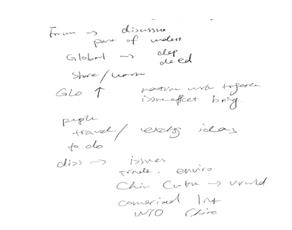
Sample 2:
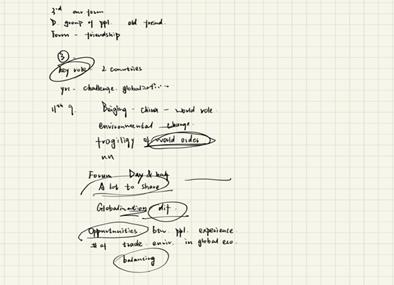
Sample 3
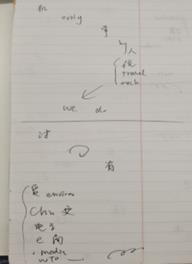
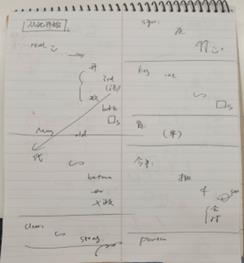

Sample 4:

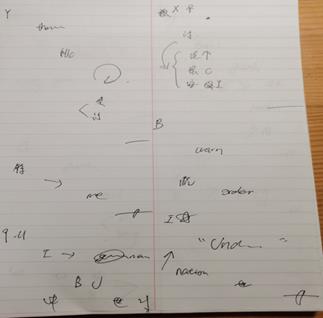


References
[1]. Nolan J.2005.Interpreting:Techniques and Exercises.Clevedon:Multilingual Matters.
[2]. Liu & M.D.Schallert&P.Carrol.“Working memory and expertise in simultaneous interpreting” Interpreting6(1):19-42. (2004).
[3]. Dam, Helle V. “The Interpreters’ Notes.” Claims, Changes and Challenges in Translation Studies, 2004, 251–61. https://doi.org/10.1075/btl.50.21dam.
[4]. Merlini Raffaella. “Interpit- consecutive interpretation module”. The Interpreter Newsletter 7:31-41.
[5]. Dam H. 2004a.Interpreters’ notes:On the choice of form and language. Claims, Changes and Challenges in Translation Studies: 6(1): 3-17.
[6]. Yuwen Wang, Dandan Zhou. An empirical study on the relationship between the content of interpreting notes and interpreting output. Journal of PLA University of Foreign Languages:115-121.2014.
[7]. Weihe Zhong. Discussion on Interpreting Teaching. Practical Interpreting Handbook:1998:18-21.
[8]. Burgin, Mark, and John H Schumann. “Three Levels of the Symbolosphere.” Semiotica 2006, no. 160 (2006). https://doi.org/10.1515/sem.2006.045.
Cite this article
Zhou,X. (2023). Note-taking Traits and Interpreting Efficiency in Consecutive Interpreting. Communications in Humanities Research,2,604-610.
Data availability
The datasets used and/or analyzed during the current study will be available from the authors upon reasonable request.
Disclaimer/Publisher's Note
The statements, opinions and data contained in all publications are solely those of the individual author(s) and contributor(s) and not of EWA Publishing and/or the editor(s). EWA Publishing and/or the editor(s) disclaim responsibility for any injury to people or property resulting from any ideas, methods, instructions or products referred to in the content.
About volume
Volume title: Proceedings of the 3rd International Conference on Educational Innovation and Philosophical Inquiries (ICEIPI 2022), Part III
© 2024 by the author(s). Licensee EWA Publishing, Oxford, UK. This article is an open access article distributed under the terms and
conditions of the Creative Commons Attribution (CC BY) license. Authors who
publish this series agree to the following terms:
1. Authors retain copyright and grant the series right of first publication with the work simultaneously licensed under a Creative Commons
Attribution License that allows others to share the work with an acknowledgment of the work's authorship and initial publication in this
series.
2. Authors are able to enter into separate, additional contractual arrangements for the non-exclusive distribution of the series's published
version of the work (e.g., post it to an institutional repository or publish it in a book), with an acknowledgment of its initial
publication in this series.
3. Authors are permitted and encouraged to post their work online (e.g., in institutional repositories or on their website) prior to and
during the submission process, as it can lead to productive exchanges, as well as earlier and greater citation of published work (See
Open access policy for details).
References
[1]. Nolan J.2005.Interpreting:Techniques and Exercises.Clevedon:Multilingual Matters.
[2]. Liu & M.D.Schallert&P.Carrol.“Working memory and expertise in simultaneous interpreting” Interpreting6(1):19-42. (2004).
[3]. Dam, Helle V. “The Interpreters’ Notes.” Claims, Changes and Challenges in Translation Studies, 2004, 251–61. https://doi.org/10.1075/btl.50.21dam.
[4]. Merlini Raffaella. “Interpit- consecutive interpretation module”. The Interpreter Newsletter 7:31-41.
[5]. Dam H. 2004a.Interpreters’ notes:On the choice of form and language. Claims, Changes and Challenges in Translation Studies: 6(1): 3-17.
[6]. Yuwen Wang, Dandan Zhou. An empirical study on the relationship between the content of interpreting notes and interpreting output. Journal of PLA University of Foreign Languages:115-121.2014.
[7]. Weihe Zhong. Discussion on Interpreting Teaching. Practical Interpreting Handbook:1998:18-21.
[8]. Burgin, Mark, and John H Schumann. “Three Levels of the Symbolosphere.” Semiotica 2006, no. 160 (2006). https://doi.org/10.1515/sem.2006.045.









